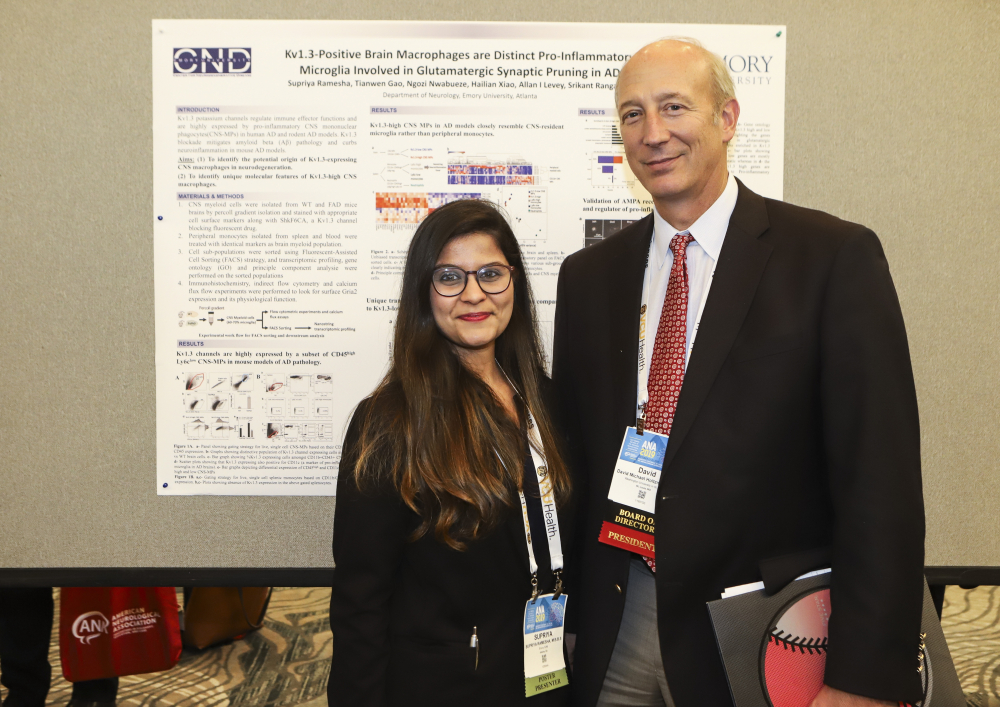 |
Supriya Ramesha, MBBS, of Emory University, with mentor and ANA Immediate Past President David Holtzman, MD, of Washington University School of Medicine (WUSTL) |
In a new event for its Annual Meeting, the ANA hosted a Mentor-Mentee Breakfast at ANA2019 in St. Louis on October 14 to enable mentors and mentees to spend some time together and network with others. What makes these relationships, fostered by ANA’s MentorLink, so helpful?
David Holtzman, MD, Chairman of Neurology at the Washington University School of Medicine (WUSTL) and ANA Immediate Past President, connected with new mentee Supriya Ramesha, MBBS, of Emory University, through the ANA’s MentorLink online. She is applying to residencies and was excited to win a travel award to present a poster at ANA2019, titled, “Kv1.3-Positive Brain Macrophages are Distinct Pro-Inflammatory Microglia Involved in Glutamatergic Synaptic Pruning in AD.”
"I'm new at the ANA and this is my first meeting," she said. "It is a great platform to showcase my work as well as meet the pioneers in neurology. Thanks to Dr. Holtzman and the Mentor-Mentee Breakfast, I learned a lot about how the ANA works."
Dr. Holtzman has also been a mentor to Suzanne Schindler, MD, PhD, at WUSL, since 1999. Schindler worked on her PhD in his lab and remained for residency.
During the Presidential Plenary at ANA2019, Schindler presented a Data Blitz paper titled, “Plasma Aβ42/Aβ40 Measured with a High Precision Assay Predicts Current and Future Brain Amyloidosis.”
“Dave is a brilliant scientist, and when I have ideas I can talk to him about it,” Schindler said. “Every time I come to him with a question, he asks me something that pushes me forward a little more.”
A strong mentor relationship persists and evolves over time, Holtzman said, adding that academic neurologists are likely to have three or four significant mentors during their careers.
“I found myself working on TREM2 and [Dr. Holtzman] is working on that too,” Schindler said. “I didn’t anticipate that 20 years ago.”
The ANA Meeting itself enhances the mentor-mentee relationship by providing a community of academic support, members noted. “It’s been great to talk to all these colleagues about the work I’ve been doing,” Schindler said. “It’s been like a reunion. I’ve seen so many people I’ve known during my career and talked to them about how their career has changed over time.”
“I see a lot of reinforcement of the importance of mentors at different career stages,” said Charlene Ong, MD, MPHS, of Boston University. “By interacting with not only senior mentors, but also people at our specific career levels, we facilitate relationships with future thought leaders,” Ong said. “These are the people we can share ideas with and try to troubleshoot the challenges unique to our career stage.” Also a travel awardee, Ong presented a poster on “Quantitative Pupillometry and Radiographic Midbrain Compression by Cerebral Edema.”
The ANA granted nearly 150 travel awards this year to fellows, residents, students, and junior faculty, a benefit that fosters stronger mentor-mentee relationships.
“My mentee couldn’t make it to the conference but the travel award is an innovative way to bring younger members in and make it a more accessible conference,” said Brendan Kelley, MD, Associate Professor of Neurology and Neurotherapeutics at UT Southwestern Medical Center. “Even though he couldn’t attend, he appreciated my nominating him.”
Argye Hillis, MD, Professor of Neurology at Johns Hopkins Medicine, served as co-chair for the ANA2019 Plenary Session on Language Disorders Across the Lifespan. Her mentee, Shannon Sheppard, PhD, also of Johns Hopkins, received a travel award to present a Data Blitz during the Language Disorders Plenary on “Cues to Improve Emotional Prosody after Right Frontal Strokes.”
“There are so many places you can take your research. It’s been so good to bounce ideas off of Argye,” Sheppard said. “She’s helped direct me on what would be best and where the field is going. I feel like the people in the lab have become a family.”
“Having mentees also quadruples your productivity,” said Hillis, a former Derek Denny-Brown awardee. “I used to do everything myself, but life is so much more fun when we share the work. And we bounce ideas off each other. If one comes in on one grant and another on another grant, they work together on projects and use each other’s strengths, and then they learn to become mentors themselves, working with medical students and undergraduates.”
Kelley agreed that mentoring others is energizing. “I enjoy working with my fellows and residents,” he said. “It’s important for my job satisfaction and feeling that the work I do is meaningful and has relevance for the future.”
He and others agreed that mentors have more to impart than scientific knowledge.
“When I think back over mentors I’ve had over my career,” Kelley said, “at least half of the value and lessons I’ve learned are the less tangible learnings of how to be a good academician and clinician. You teach by example as well.”
“As I have trainees, residents, medical students, and PhD candidates working with me, I think about the skills I’ve learned — the softer things that you don’t read in a textbook. I really try to impart these when we’re having discussions,” Ong said. “We think about the type of lab and culture we want to create.”
“There are so many beneficial aspects of a mentor-mentee relationship. It is equally important to identify who good mentors are and to train them,” Ong added. “Not everyone has had the training or has put effort into acquiring these skills. That can be a big setback to a young investigator.”
###
To be a mentor or find a mentor outside your institution who shares your interests and can add a valuable new dimension to your career, visit ANA MentorLink.
